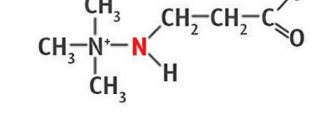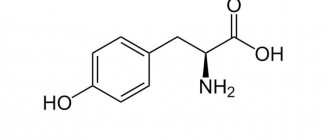Amino acids are extremely important for our body. In total, today doctors identify many names of essential and non-essential amino acids that come with food. Today we are interested in glutamic acid. In bodybuilding, this is one of the most important nutritional elements, which is responsible for the secretion of growth hormone, which is extremely important when gaining muscle mass. Today we want to take a closer look at this amazing amino acid and tell you how it is used around the world.
Glutamic acid – what is it?
In all living beings, glutamine, respectively, and glutamic acid are found in proteins, low-molecular substances and in a free state. It is an organic compound that has two acid groups and is classified as a conditionally essential amino acid.
Glutamic acid, or more precisely, its synthetic analogue, is found in many foods and acts as a flavoring additive and has a “meaty” taste.
When reading the composition of any product, you can pay attention to the following additives:
- Neurotransmitter E620;
- E624;
- E622;
- E621;
- E625.
All of these are glutamates, that is, substances obtained from glutamine combined with magnesium, potassium, sodium, etc. If such “E” are present, then this is all synthetic glutamic acid. But even in its natural form, glutamine is present in foods in quantities sufficient for humans.
What foods contain glutamic acid?
According to doctors, it is very difficult to eliminate glutamine from the diet 100%, since it is contained in a sufficient amount of the foods we consume. They include:
- hard varieties of cheese;
- cow's milk;
- eggs;
- duck meat, young chicken;
- pork;
- beef;
- Fish and seafood;
- vegetables: carrots, beets, green peas, corn, onions, tomatoes, peppers;
- mushrooms;
- walnuts;
- soy sauce.
Foods high in glutamine
One way or another, glutamate is present in the diet of any person. The only difference is the amount of glutamic acid consumed. What does this give? The amount of amino acid consumed affects the nervous system, skin cell regeneration, as well as the energy produced by a person.
Glutamic acid is found in free or bound form in all the foods listed above. Sometimes, during the process of heat or other culinary processing, glutamate changes from bound to free form, which is why a change in taste occurs.
The largest amounts of glutamic acid are found in Kombu and Nori seaweeds.
It is no coincidence that the discovery of this amino acid occurred in Japan, where these products are abundant.
Glutamic acid as a drug
It is well known that glutamic acid is a substance that can be of not only natural but also synthetic origin. In other words, if there is a lack of glutamine, you can take special medications to make up for its deficiency in the body.
It is worth noting that the synthetic form is in no way inferior to naturally obtained glutamine, has the same effect on the body and is just as easily absorbed.
Most pharmacological companies represented on the Russian market produce glutamine-containing drugs. The amount of amino acid in different products varies.
Thus, we can distinguish:
- single-component preparations containing only glutamic acid;
- multicomponent drugs that contain other components.
The pharmacological effect of glutamic acid is nootropic. That is, drugs with a high content of artificial glutamine affect the brain, stimulating the functioning of certain of its functions.
Glutamic acid belongs to the following pharmacological groups:
- Detoxifying agents;
- Proteins, amino acids;
- Other neurotropic drugs.
Release form, composition, active substance
The most common form of release is coated tablets. The main active component is glutamic acid itself; other auxiliary substances may also be present, but their dosage is minimal.
They are needed so that this amino acid is absorbed quickly and completely in the body. Also, excipients help maintain the specific form in which glutamine is released.
There are other release options: powdered and in the form of granules to obtain a suspension. Each dosage form is developed by specialists so that the active substances begin their action in the body as quickly as possible.
Speaking about a one-component drug, we can highlight the main active ingredient - glutamic acid, and auxiliary components. They are often represented by potato starch, gelatin, talc and calcium.
Their variability is possible due to changes in the form of the drug, or at the discretion of the drug manufacturer.
Why does the body need glutamic acid?
Scientists have proven the fact that this amino acid is one of the 20 most important for the human body.
Glutamic acid - what is it, a necessity for the body
Glutamine has the following abilities:
- regulate acid-base balance;
- quickly deliver the necessary microelements;
- stimulate the growth of new skin cells;
- slow down skin aging processes;
- increase nitrogen levels in the body;
- build immunity;
- neutralize ammonia formed in the body;
- synthesize folic acid;
- help the body endure physical and psychological stress;
- establish metabolic processes;
- increase mental abilities.
This is how glutamic acid works. A properly balanced diet high in glutamine will be the main condition for tight and healthy skin. If a person eats “haphazardly,” then the balance is lost and destruction of cells and then tissue occurs.
And this applies not only to the skin. Nerve cells are destroyed, connections between other amino acids are lost, etc.
Glutamine amino acid, obtained from food or special medications, has a wide range of actions, but self-prescription of drugs is not recommended, only after consulting a specialist.
Don’t miss the most popular article in the section: Glutamic acid - what it is, why and how it is used in sports and bodybuilding.
Differences from glutamine
Many people, including athletes, are interested in the difference between glutamic acid and glutamine. It is important to know that these elements are considered amino acids, but function differently. In some cases, the acid is called glutamic acid. However, this is not true, since glutamine is a separate substance with different properties and effects on the body.
Glutamine largely affects the quality of protein metabolism and nitrogen balance. For this reason, it is used in strength sports and bodybuilding. The product is present in specific sports dietary supplements that are used for muscle growth.
Glutamic acid has a nootropic effect and provides energy to the brain. It is able to support the activity of the central nervous system, increases the body's resistance to high stress, and also performs many other useful functions. However, it does not have a direct effect on muscle volume, it only helps.
Instructions for use. Indications for use
Having found wide application in medicine, glutamic acid helps to cope with many ailments, positively affecting the human nervous system.
This is the most prescribed drug for:
- epilepsy;
- schizophrenia;
- cerebral palsy;
- severe mental disorders, psychosis;
- prolonged depression;
- polio;
- child development delay;
- suffered consequences of encephalitis, meningitis.
Glutamic acid is prescribed in combination with other medications. It becomes clear that this amino acid helps improve the patient’s condition in many disorders, both physical and psychological.
Therefore, hearing the question “Glutamic acid – what is it?” any doctor will explain to the patient about the clear benefits of the drug used.
Effect on the body
Nonessential amino acids, synthesized industrially as drugs, have little effect on the body on their own, so they are used in combination with other potent components. The amino acid belongs to the category of dietary supplements. Most often it is used in sports nutrition in order to increase performance. The element quickly reduces the intoxication of metabolic processes and restores after exercise.
One of the 20 most important amino acids in the human body can provide the following benefits:
- Improves metabolic connections in the cells of the nervous system.
- Strengthens the immune system, makes the body resistant to injury, poisoning and infections.
- It is an activator of redox reactions in the brain and protein metabolism. Acts on the function of the endocrine and nervous systems, regulating metabolism.
- Quickly transports microelements, stimulates the formation of skin cells.
- Helps produce folic acid, reduces mental stress, improves memory.
- Glutamic acid compounds remove ammonia from the body, thereby reducing tissue hypoxia.
- The amino acid, with the help of the myofibril component and other elements included in the preparations, helps retain the required amount of potassium ions in the brain tissue.
- The component acts as an intermediary between the metabolic reactions of nucleic acid and carbohydrates. Refers to hepatoprotectors, reduces the secretion of stomach cells.
- Synthesizes protein, improves the body's endurance, reduces cravings for alcohol and sweets.
If you properly balance your diet with glutamine in mind, your skin will become tightened and healthy. Poor nutrition leads to the destruction of skin cells, nerve fibers and the relationship of amino acids. Despite all the positive properties of the amino acid, you should not take it without a doctor’s prescription.
Contraindications for use
There are also some conditions when taking this drug is prohibited:
- high sensitivity to the active substance of the drug;
- obesity;
- fever;
- renal and liver failure;
- anemia;
- severe excitability;
- stomach ulcer;
- nephrotic syndrome.
Excessive nervous excitability is a contraindication for taking glutamic acid.
The doctor prescribes the dosage depending on the complexity and nature of the disease. The course is at least 1-2 months, but can be up to 6-12 months. Also, while taking the medication, it is necessary to undergo regular tests to monitor the patient’s condition.
It is always necessary to remember: from an excess of glutamic acid, excess glutamine can accumulate in the intercellular space, which leads to the death of nerve cells, obesity, disruption of metabolic processes and even the functioning of the heart.
Glutamic acid for weight gain
Glutamic acid alone will not help you gain weight, but no muscle gain course should be completed without it. Why is glutamine so important? The first thing that is important when gaining weight is stimulation of metabolism, and for this, cells need good nutrition with a spectrum of amino acids, and glutamine is converted into other amino acids quickly and efficiently. In addition to accelerating metabolic and oxidative processes, a non-essential amino acid can improve immunity and make the process of weight gain healthy.
Find out if there are weight gain pills and how to take them correctly.
What is glutamic acid used for in sports?
In addition to its medical benefits, glutamic acid has other benefits: it is not that expensive and is an integral part of the life of professional athletes.
Sports nutrition manufacturers produce about 3.5 million tons of pure amino acids per year, as well as many drugs with various additives. In this form, it can be bought both in pharmacies and in specialized stores.
The benefits of this amino acid are obvious. Glutamine mainly synthesizes various amino acids in the body (its work accounts for about 50% of all such processes).
So, with a large amount of glutamine, muscle performance and endurance increase significantly. The time it takes for an athlete to recover muscles after physical activity is proportionally reduced.
If there is enough glutamine in the body, then potassium ions are freely distributed in muscle cells. Thanks to this process, the muscles begin to contract better, therefore, their functionality increases.
Some athletes use glutamic acid not in its pure form, but in combination with substances such as glycine and cystine. These combinations help increase the endurance of all muscles, as well as normalize the functioning of the cardiovascular system.
But despite all the positive effects of glutamic acid on the body, experts warn: you should not expect stunning results from the drug, since this amino acid is not an anabolic steroid.
Although most athletes who consume glutamine note an improvement in their general condition, quick recovery after training, and better muscle function.
How glutamic acid is used in bodybuilding
Glutamic acid helps bodybuilders significantly. If you know what it is and apply it correctly, you can improve not only the quality of your skin, but also gain the necessary weight.
Although the drug itself does not affect weight gain, it indirectly contributes to it:
- Firstly, proper metabolism is important when gaining weight. With the modern rhythm of life and the consumption of “artificial” food, this process is disrupted in the majority of our compatriots. To resume metabolic processes, many amino acids are needed. Glutamic acid, when broken down, turns very quickly into exactly what the body needs;
- Secondly , good immunity helps speed up the process of gaining muscle mass, which is facilitated by glutamine;
- Thirdly , this acid is a conductor of nitrogen into the human body. It is no secret that thanks to nitrogen metabolism, muscle cells grow at an accelerated pace;
- Fourthly , for professional athletes who use steroids, glutamine is necessary in order not to undermine their health, as its vulnerability becomes higher.
A beautiful body is also important for athletes. And here glutamic acid is an indispensable assistant. The amino acid acts in such a way that the cell regeneration process accelerates, the skin itself becomes softer and looks radiant.
Increased need for protein
Who knows this more than professional athletes? During intensive weight gain, they have to absorb huge amounts of protein foods, and additionally protein shakes. When they break down, an incredibly toxic substance is formed - ammonia. To prevent the body from being poisoned by it, under the influence of glutamine, ammonia is converted into urea, which is excreted naturally. Additionally, the amino acid helps stimulate the activity of the adrenal glands.
Dosage regimens, dosage
For each organism, for each disease or its prevention, an appropriate regimen of glutamic acid is prescribed. But there are also universal tips on how to do this. They can be read in the instructions for the drug.
Usually the drug is taken 2-3 times a day, in the morning and afternoon, every day. Glutamic acid is not a quick-acting pill, so it is very important to take the medication in a course, every day.
Athletes can add glutamine to protein or gainer, or dilute it with water. Important! If there was a workout on the day you took glutamic acid, it is better to take the tablet in the morning and immediately after finishing it.
If the drug is taken for prevention, then you can start taking it in the autumn or spring, when the immune system needs support more than ever. It is recommended to take the tablets 10 minutes before meals or during meals.
The dosage is calculated depending on gender, age and weight. To increase muscle functionality, girls need about 5 grams 2 times a day, men – 5-10 grams 2 times a day.
Doctors still insist on preliminary consultation so that the patient does not receive unexpected effects from taking the drug or an overdose of glutamine.
Myth or not?
Glutamine is highly valued in the bodybuilding world for a number of the above reasons. But this substance is also very often criticized. Some scientists hypothesize that this drug is useless for muscle growth and recovery.
And others, such as the American doctor John Only, went even further. He claims that glutamine harms the retina of the eye, according to studies done on rats. His assumptions were not confirmed, and a similar effect was not found in humans. But these statements did not go unnoticed; many bodybuilders, impressed by the information received, reported many negative symptoms.
Among them were severe headaches, fever, tachycardia and slow reactions. But all these reactions have not been confirmed by research. Later it became clear that this was all exaggerated by the media, but many are still wary of this supplement.
P.S.
Subscribe to blog updates,
so you don't miss anything!
If you want to purchase any sporting goods, sports nutrition or supplements, you can use this special page!
One tablet of Glutamic acid contains 250 mg of the active substance of the same name.
Additional substances: povidone, potato starch, calcium stearate monohydrate, talc.
Shell composition: talc, sucrose, titanium dioxide, silicon dioxide, povidone, liquid paraffin, beeswax.
Glutamic acid for children
Children may also suffer from certain mental disorders, congenital disorders, or acquired neurological conditions. In such cases, specialists prescribe glutamine, which is one of the links in maintenance therapy.
There are not many medications approved for children under one year of age, but glutamic acid is one of them. A doctor may prescribe a course of tablets for:
- postnatal injuries,
- polio and its consequences,
- cerebral palsy,
- oligophrenia,
- ZPR.
There are also dosages for children (for a single dose of the drug):
- for babies of the first year of life – no more than 100 mg;
- children 1-2 years old - no more than 150 mg;
- children 3-4 years old - no more than 250 mg;
- children 5-6 years old - no more than 400 mg;
- children 7-9 years old – no more than 500 mg;
- from 10 years – 1000 mg.
These dosages can be increased at the discretion of the attending physician; the number of doses per day can also vary: 1 or 2 per day.
Glutamic acid in gynecology
It is a well-known fact: to give birth to healthy children, you need to pay close attention to the period of pregnancy planning. But it is not always possible for a woman to get pregnant quickly. Some diseases can be treated with the use of glutamic acid.
By stimulating blood circulation, glutamine promotes rapid recovery of the reproductive system after surgical interventions. Hormonal disorders are traditionally treated with hormonal therapy, but glutamine amino acid plays an important role here too.
If you have an irregular cycle or rare ovulation, this drug can also be prescribed, because with such diagnoses it is very difficult to get pregnant.
The treatment regimen is prescribed according to the woman’s cycle:
- In the first half, the doctor prescribes drinking vitamin E (prepares the endometrium for the attachment of a fertilized egg) and folic acid (prevention of abnormalities in the development of the embryo);
- In the second half of the cycle, the woman is also recommended to take vitamin E, but now in triple dosage, as well as glutamic acid, which speeds up metabolism and improves blood circulation.
Any disruption of the female reproductive system is treated exclusively by professionals, and many of them are supporters of taking glutamic acid even during pregnancy.
Don't miss the most popular article in the section: Body drying for girls. Training program, detailed nutrition menu for the month by day.
Possible side effects
Uncontrolled intake of acid may result in:
- Allergy,
- Nausea and vomiting,
- Severe abdominal pain
- Loose stools
- High excitability.
If the drug is taken for too long a period of time, it accumulates in the body and the following are possible:
- Low hemoglobin,
- Leukopenia,
- Cracks around the mouth and lips
- Irritation in the mouth.
Where to buy, price, storage conditions, expiration date
In its pure form, a drug called “Glutamic acid” is very easy to find; it can be the nearest pharmacy or a specialized sports nutrition store. The amino acid costs on average from 17 to 85 rubles per package (10 tablets of 250 mg). When it comes to sports supplements with glutamine, the price per jar will be much higher.
The tablets are available without a prescription, the shelf life is 3 years when stored at a temperature not exceeding 25 degrees. Not only athletes who use glutamic acid know what it is, but also many parents of children with disabilities, women of reproductive age and simply people who are attentive to their health.
Having a large number of beneficial properties, glutamic acid is available to everyone. A deficiency of this amino acid leads to various unpleasant processes in the body, which is why its replenishment is so important all year round.
Release form
Before deciding how to use glutamic acid in bodybuilding, it is worth finding out what forms the product comes in. They are different, but the following forms are often found:
- tablets of 0.25 grams, coated;
- powder;
- capsules;
- tablets of 0.25 and 0.5 grams, which dissolve in the intestines;
- one percent solution in ampoules of 10 ml.
In sports, as a rule, they use capsule or powder form. Each capsule manufacturer includes a different amount of glutamic acid in its capsules. For example, capsules of 1 gram may be found. Information about the contents is contained on the packaging of the product.










